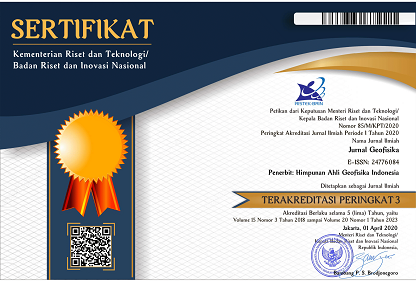Pemetaan Daerah Rawan Longsor Menggunakan Machine Learning di Kecamatan Muara Tami, Kota Jayapura, Papua
Keywords
Muara Tami, landslides, random forest, machine learning.Abstract
One of the high landslide vulnerability areas in Indonesia is located in Muara Tami District, Jayapura City. The main factors triggering the landslide are steep slopes and high elevations. However, there are still several other factors that also influence the occurrence of landslides, such as vegetation, land cover, and curvature. Landslides that occur can cause damages to all parties, both material and non-material. Therefore, it is necessary to map landslide-prone areas as a non-structural mitigation planning. This planning is useful for identifying areas that are relatively safer from landslides so that the fatalities incurred can be minimized. In this mapping, several parameters are used that are thought to trigger landslides, then they are calculated by machine learning using the random forest method. Based on the parameters used, the eastern and northwestern areas have high slope and elevation values, high curvature contrast values, and dry land forest cover. These results indicate the high potential for landslide vulnerability in both parts of the study area. Meanwhile, areas with low potential for landslide vulnerability have a curvature of 0, a relatively low slope and elevation. The model accuracy value obtained by the random forest method is 0.9. This value is categorized as good enough because it shows that the parameters used are good enough in mapping landslide vulnerability in the study area. These results are also supported by the high sensitivity and specificity values based on the ROC curve. Areas with high potential for landslide vulnerability are Mosso Village and the border between Skow Mabo, Skow Yambe, Koya Tengah, Koya Timur, and Holtekam. Meanwhile, areas with low landslide potential were Skow Sae Village, the central part of East Koya, the northern part of West Koya, and the southern part of Holtekam.
References
Audinno, Rizky Teddy dkk. (2014): Investigasi Geologi Potensi Longsor Berdasarkan Analisis Sifat Fisik dan Mekanik Batuan Daerah Kota Balikpapan, Kalimantan Timur. Prosiding Seminar Nasional Kebumian Ke-7, Jurusan Teknik Geologi, Fakultas Teknik, UGM.
Badan Perencanaan Pembangunan Daerah (Bappeda) Kota Jayapura. (2017). Rencana Pembangunan Jangka Menengah Daerah (RPJMD). Papua.
Breiman, L. (1999): Random Forest-Random Features. Technical Report 567. Statistic Departement, University of California, Berkeley. ftp://ftp.stat.berkeley.edu/pub/users/breiman.
Breiman, L. (2001): Random Forest. Machine Learning, Vol. 45, no. 1, hal. 5–32.
Cahyono, B. E., Febriawan, E. B., dan Nugroho, A. T. (2019): Analisis Tutupan Lahan Menggunakan Metode Klasifikasi Tidak Terbimbing Citra Landsat di Sawahlunto, Sumatera Barat. TEKNOTAN, Vol. 13, No.1. doi: 10.24198/jt.vol13n1.2.
Chen, W., et al. (2017): A Comparative Study of Logistic Model Tree, Random Forest, and Classification and Regression Tree Models for Spatial Prediction of Landslide Susceptibility. Catena, 151, 147-160.
Choi, J., et al. (2012): Combining Landslide Susceptibility Maps Obtained From Frequenct Ratio, Logistic Regressuin, and Artificial Neural Network Models Using ASTER Images and GIS. Engineering Geology, 124, 12-23.
Cruden,D.M. & Varnes, D.J. (1996): Landslide Types and Processes. Transportation Research Board, U.S. National Academy of Sciences, Special Report, 247: 36-75.
Ding, Q., et al. (2017): Application of Frequency Ratio, Weights of Evidence and Evidential Belief Function Models in Landslide Susceptibility Mapping. Geocarto Int, 32, 619-639.
Id, Ibnu Daqiqil. (2021): Machine Learning: Teori, Studi Kasus dan Implementasi Menggunakan Python. Riau: UR Press.
Kanungo, D.P., et al. (2006): A Comparative Study of Conventional, ANN Black Box, Fuzzy and Combined Neural and Fuzzy Weighting Procedures for Landslide Susceptibility Zonation in Darjeeling Himalayas. Engineering Geology, 85(3-4), 347-366.
Kim, J. C., et al. (2017): Landslide Susceptibility Mapping Using Random Forest and Boosted Tree Models in Pyeong-Chang, Korea. Taylor & Francis Group: Geocarto International.
Krebs, P. dkk. (2015): An Alternative Approach to Transverse and Profile Terrain Curvature. International Journal of Geographical Information Science. doi: 10.1080/13658816.2014.995102.
Mitchell, Tom A. (1997): Machine Learning. McGraw-Hill.
Naveen, R.T., Ram, M.V., Backiaraj, S., Muthusamy, S. (2011): Landslide Hazard Zonation Using The Relative Effect Method in South Eastern Part of Nilgris, Tamilnadu India. International Journal of Engineering Science and Technology, 3(4), 3260-3266.
Nourani, V., et al. (2014): Lanslide Susceptibility Mapping at Zonouz Plain, Iran Using Genetic Programming and Comparison with Frequency Ratio, Logistic Regression and Artificial Neural Network Models. Natural Hazards, 71(1), 523-547.
Nugroho, Danang D., Nugroho, H. (2020): Analisis Kerentanan Tanah Longsor Menggunakan Metode Frequency Ratio di Kabupaten Bandung Barat, Jawa Barat. Journal of Geodesy and Geomatics, 16(1).
Pradhan, B. (2010): Landslide Susceptibility Mapping of A Catchment Area Using Frequency Ratio, Fuzzy Logic and Multivariate Logistic Regression Approaches. Journal of the Indian Society of Remote Sensing, 38(2), 301-320.
Pusat Penelitian Tanah dan Agroklimat (PUSLITANAK). (2004): Petunjuk Teknis Evaluasi Lahan. Badan Penelitian dan Pengembangan Pertanian, Departemen Pertanian.
Romstad, B. & Etzelmüller, B. (2012): Mean-Curvature Watersheds: A Simple Method for Segmentation of A Digital Elevation Model Into Terrain Units. Geomorphology, 139-140, 293-302, doi: 10.1016/j.geomorph.2011.10.031.
Sheila, B. (1992): Penghantar Tentang Bahaya Edisi ke- 3. Jakarta: UNDP.
Suwarna & Noya. (1995): Peta Geologi Lembar Jayapura (Peg. Cycloops), Irian Jaya Skala 1:250.000. Pusat Penelitian dan Pengembangan Geologi.
Taufiq, H.P., dan Suharyadi. (2008): Landslide Risk Spatial Modelling Using Geographical Information System. Laboratorium Sistem Informasi Geografis, Fakultas Geografi Universitas Gadjah Mada.
Tokar, O., Vovk, O., Kolyasa, L., Havryliuk, S., dan Korol, M. (2018): Using the Random Forest Classification for Land Cover Interpretation of Landsat Images in the Prykarpattya Region of Ukraine. IEEE 13th International Scientific and Technical Conference on Computer Sciences and Information Technologies (CSIT), pp. 241-244, doi: 10.1109/STC-CSIT.2018.8526646.
Weier, J. & Herring, D. (2000): Measuring Vegetation (NDVI & EVI). Washington DC: NASA Earth Observatory.
Wilson, J.P., & Gallant, J.C. (2000): Terrain Analysis: Principles and Applications. New York: John Wiley and Sons.
Youssef, A. M., et al. (2015): Landslide Susceptibility Mapping Using Random Forest, Boosted Regression Tree, Classification and Regression Tree, and General Linear Models and Comparison of Their Performance at Wadi Tayyah Basin, Asir Region, Saudi Arabia. Landslides, 1-18.

This work is licensed under a Creative Commons Attribution 4.0 International License.
The copyright of all articles belongs to the authors. All other copyrights is held by the Journal











